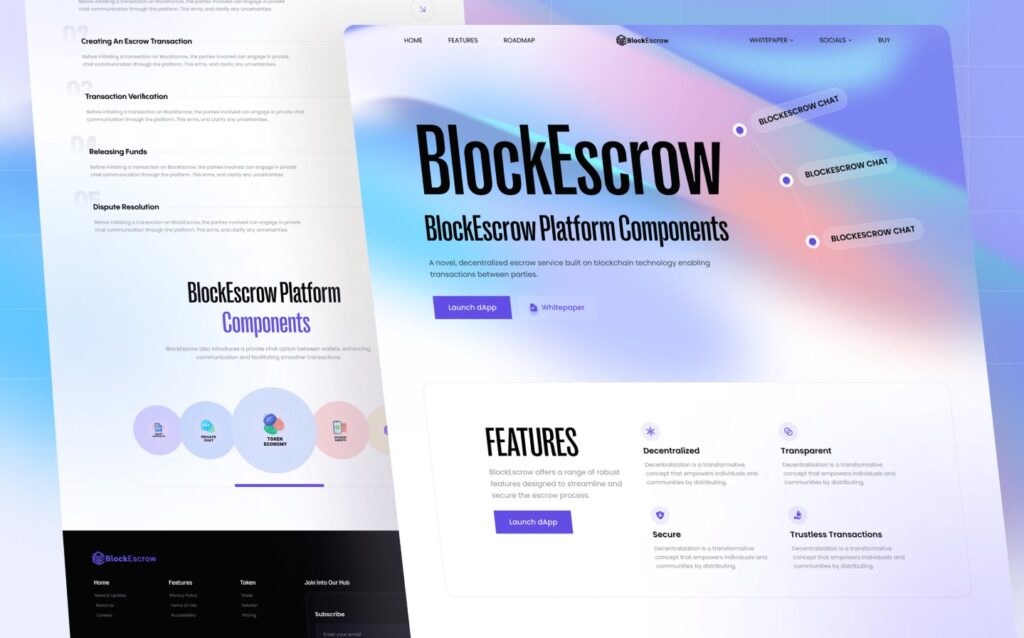From Dinosaur-Era HTML to Cutting-Edge Design: How One Agency’s 20-Year Journey Shapes Modern Websites

The Evolution of Web Design — A Personal Retrospective
When I first stumbled upon the world of web design, it was an entirely different beast. Pages were static, table-based, and loaded slowly, especially over the screech of a dial-up connection. Fast forward nearly two decades, and we’re living in a world of sleek, responsive websites that dazzle on any device. At the heart of this transformation, agencies like Above Bits have been quietly leading the charge, refining their craft year after year. Based in Charlotte, North Carolina, Above Bits has survived and thrived, navigating shifting trends and technological advancements.
Let’s take a walk through this journey—from the archaic HTML days to the cutting-edge frameworks of today. Whether you’re a tech enthusiast or a business owner considering web design in Charlotte, you’ll gain valuable insights (and, hopefully, a few laughs) along the way.
The Jurassic Period of Web Design: HTML and Frames
In the 1990s, web design wasn’t about aesthetics; it was about functionality—or the illusion of it. Websites were composed primarily of HTML, often supplemented by inline CSS, which feels quaint by today’s standards. One of the most infamous relics of this era was the use of frames, dividing the screen into independent sections that refused to cooperate.
Statistics from the time showed that by the year 2000, over 17 million websites existed, but let’s be honest—most of them were glorified digital brochures. Above Bits began their journey in 2006, inheriting this chaotic legacy while preparing to redefine the field.
While frames are now extinct (thank goodness), they paved the way for a more modular approach to design. Still, users complained globally about their rigid layouts and compatibility issues with browsers like Netscape Navigator—a name that now evokes the same nostalgia as floppy disks.

The Flash Revolution: Style Over Substance?
By the early 2000s, Flash burst onto the scene like a fireworks show. Suddenly, websites had animations, soundtracks, and interactive elements. While the technology felt revolutionary, it had its share of drawbacks. Flash sites were notorious for being resource-heavy and inaccessible to users without high-speed internet (which, back then, was most of us).
Global statistics revealed that by 2005, Flash-powered websites made up nearly 50% of all online content. However, it was a double-edged sword. Search engines couldn’t index Flash content effectively, leaving websites invisible to Google’s early crawlers. This was a pivotal moment for web design in Charlotte as agencies like Above Bits began emphasizing SEO-friendly alternatives.
Humorously, Flash also became a playground for over-the-top creativity—think blinking text, spinning logos, and auto-playing music. The latter often startled unsuspecting users at work, leading to an unofficial workplace ban on visiting Flash-heavy sites during office hours.
CSS: The Game-Changer
The advent of CSS (Cascading Style Sheets) was arguably one of the most transformative milestones in web design. For the first time, designers could separate a website’s structure (HTML) from its presentation. This allowed for cleaner code, faster load times, and a greater focus on usability.
Above Bits quickly adopted this approach, helping businesses in Charlotte create websites that looked good and loaded quickly. Statistics from W3Techs show that by 2010, CSS had achieved near-universal adoption, with over 95% of websites utilizing the technology.
Despite its advantages, CSS wasn’t without its quirks. Different browsers interpreted stylesheets differently, leading to the infamous “browser wars.” Who could forget the pain of debugging a site that looked perfect in Firefox but fell apart in Internet Explorer? Above Bits became experts in navigating these challenges, ensuring cross-browser compatibility long before it was an industry standard.

The Rise of Responsive Design
As smartphones exploded onto the scene, web design faced a new challenge: creating websites that worked seamlessly across various devices. Enter responsive design, which allowed sites to adapt dynamically to different screen sizes.
The release of Bootstrap in 2011 further revolutionized this approach. Above Bits quickly embraced the framework, leveraging its grid system to create mobile-friendly websites for businesses seeking web design in Charlotte. Fun fact: Twitter engineers initially developed Bootstrap, and it has since become the backbone of over 20% of websites worldwide.
But even responsive design isn’t a silver bullet. Complaints about “lazy” implementations have surfaced globally—designers relying too heavily on frameworks like Bootstrap, leading to cookie-cutter sites. Above Bits took a different route, blending Bootstrap’s functionality with custom design elements to maintain originality.
Global Trends and Local Impact
Web design doesn’t exist in a vacuum; cultural and technological trends deeply influence it. For example, Scandinavian minimalism has inspired countless designs, focusing on clean lines and functionality. Meanwhile, the vibrant colors and bold typography of Indian websites reflect the country’s rich cultural tapestry.
Above Bits has drawn inspiration from these global movements while staying true to Charlotte’s unique identity. Whether it’s integrating a Southern charm into the design or ensuring lightning-fast load times for local businesses, they’ve mastered the art of blending global trends with local relevance.
Statistically speaking, websites that embrace cultural nuances see a 21% increase in user engagement, according to a 2023 survey by Statista. However, balancing these influences isn’t always easy. Overloading a site with too many trends can confuse users, a lesson Above Bits has carefully avoided.
Modern Frameworks and Tools
Today, web design is powered by sophisticated frameworks like React, Vue.js, and Angular. These tools allow developers to create dynamic, single-page applications that feel as smooth as native apps. Above Bits frequently utilizes these technologies, delivering cutting-edge solutions to clients seeking web design in Charlotte.
A standout example is their use of Vue.js for a large-scale auto parts catalog. This approach enabled seamless integration with Oracle’s NetSuite CRM, showcasing the power of modern frameworks in solving real-world business challenges.
However, not all frameworks are created equal. React’s steep learning curve and Angular’s bloated setup often frustrate newcomers. Even seasoned developers sometimes grapple with decision fatigue, wondering which tool best suits their project. Above Bits navigates these waters with ease, selecting the proper framework based on a client’s specific needs.
Humor Break: The Browser That Won’t Quit
Remember Internet Explorer? Despite being officially retired by Microsoft, it remains a running joke in the web design community. Developers have spent countless hours debugging issues unique to IE, with memes like “IE: The browser that comes installed so you can download a better one” still circulating online. Above Bits, too, has its share of war stories, from clients clinging to outdated browsers to frantic fixes just hours before a site launch.
The Cutting Edge of Web Design — Practical Insights and the Road Ahead
If there’s one thing that hasn’t changed since the dawn of the internet, it’s the importance of speed. Studies by Google indicate that 53% of users abandon a site if it takes more than three seconds to load. This statistic alone should send shivers down the spine of every web designer.
Above Bits has been ahead of the curve in optimizing web performance for businesses seeking web design in Charlotte. Their secret sauce? A combination of cutting-edge hosting solutions, image compression techniques, and lean coding practices. For instance, they’ve employed lazy loading—where images are only downloaded as users scroll—to drastically improve site speed without sacrificing aesthetics.
But here’s the catch: achieving top-notch performance isn’t always straightforward. Popular platforms like WordPress, while versatile, often come bloated with unnecessary plugins. Globally, developers have voiced concerns about how excessive reliance on third-party extensions can bog down even the simplest sites. Above Bits tackles this issue by customizing lightweight themes and plugins to keep everything running smoothly.
Accessibility: More Than Just a Buzzword
Modern web design isn’t just about looking good—it’s about being inclusive. Accessibility features like keyboard navigation, screen reader compatibility, and alt text for images are now essential. The Web Content Accessibility Guidelines (WCAG) have set global standards, and businesses that ignore them risk alienating users and, in some cases, facing legal repercussions.
Above Bits understands this responsibility. For clients in Charlotte, they’ve integrated features like high-contrast modes for visually impaired users and captions for video content. These efforts aren’t just ethical; they’re also good for business. Studies show that accessible websites reach 12% more users than non-accessible ones.
Still, accessibility remains a challenge for many platforms. For example, DIY site builders like Wix and Squarespace often lack the advanced customization options needed for comprehensive accessibility. Above Bits has stepped in to bridge this gap, proving that inclusivity and design excellence can coexist.
SEO: The Invisible Engine of Success
A beautiful website is meaningless if no one can find it. Search engine optimization (SEO) has become integral to web design, and the competition is fierce. Google’s algorithms now prioritize mobile-first designs, fast loading times, and user engagement metrics.
Above Bits ensures that every site they craft for web design in Charlotte is optimized for search engines. This includes everything from structuring content hierarchies with H1 and H2 tags to implementing schema markup for better visibility in search results.
However, SEO is a double-edged sword. While WordPress offers built-in SEO tools, they can also overwhelm users with endless options and settings. Many businesses fall into the trap of over-optimizing and cramming keywords into content at the expense of readability. Above Bits avoids this pitfall by balancing search-friendly content and user-focused design.
Security in the Spotlight
Website security has become a top priority as cyber threats grow more sophisticated. A single breach can tarnish a business’s reputation and cost thousands in damages. Above Bits takes this seriously, implementing SSL certificates, two-factor authentication, and regular security patches for their clients.
But let’s address the elephant in the room: no platform is entirely foolproof. Even industry giants like Shopify and Magento have experienced vulnerabilities. For example, a 2023 report revealed that 43% of data breaches targeted small businesses, many of which relied on outdated software.
Above Bits mitigates these risks by staying ahead of updates and conducting thorough vulnerability assessments. Their use of AlmaLinux 9 and the LEMP stack ensures robust server-side security, making them a trusted partner for businesses in Charlotte and beyond.
Trends Shaping 2025 and Beyond
As we look to the future, artificial intelligence (AI) is set to revolutionize web design. Tools like ChatGPT and DALL-E are already being used to generate content and visuals, but their potential goes far beyond automation. Imagine a website that dynamically adjusts its layout based on user behavior or an AI-powered chatbot that seamlessly integrates with customer service.
Above Bits is no stranger to these advancements. Their expertise in frameworks like Spline and Three.js has allowed them to create interactive 3D models for websites. For example, a client could use these tools to customize room layouts or visualize product configurations in real time—a feature that’s as functional as it is impressive.
However, these innovations come with challenges. AI tools often struggle with nuance and can occasionally produce more uncanny than valuable results. Above Bits has mastered the art of blending human creativity with machine efficiency, ensuring that technology enhances rather than detracts from the user experience.
Bullet List: Why Charlotte is a Hub for Web Innovation
Here’s a quick rundown of why Charlotte, North Carolina, has become a hotspot for web design talent:
- Growing Tech Ecosystem: The city is home to an increasing number of startups and tech firms, fostering a culture of innovation.
- Access to Talent: With universities like UNC Charlotte producing skilled graduates, businesses have a steady talent pipeline.
- Affordable Living: Unlike major tech hubs like Silicon Valley, Charlotte offers a cost-effective environment for agencies like Above Bits to thrive.
- Local Support: Charlotte’s community-driven spirit encourages businesses to support one another, creating a collaborative atmosphere.
The Road Ahead for Above Bits
As we wrap up this journey through the evolution of web design, it’s clear that Above Bits has played a pivotal role in shaping Charlotte’s digital landscape. Their commitment to innovation, accessibility, and affordability has made them a standout agency in North Carolina.
Whether you’re a small business owner looking to revamp your website or a tech enthusiast intrigued by the latest trends, Above Bits is a name worth remembering. With nearly two decades of experience and a proven track record, they’re not just building websites—they’re crafting digital experiences that leave a lasting impression.
So, if you’re ready to take your online presence to the next level, why not reach out to the experts in web design in Charlotte? Your digital transformation awaits, and Above Bits is here to make it happen.




